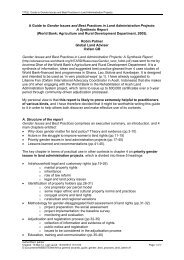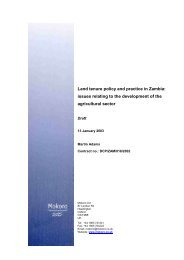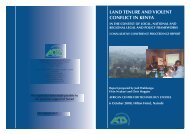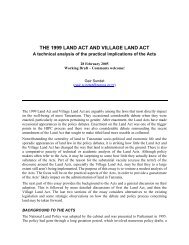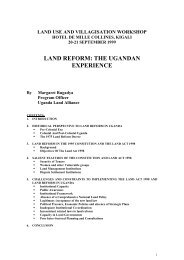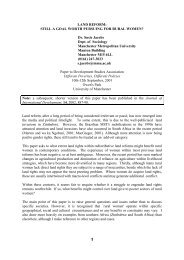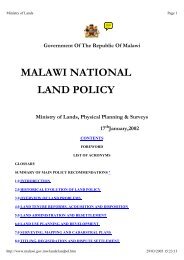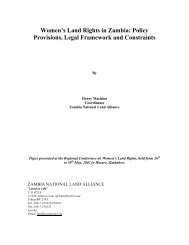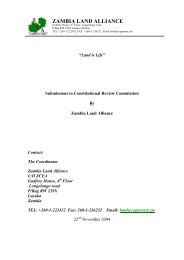Download - Mokoro
Download - Mokoro
Download - Mokoro
- No tags were found...
You also want an ePaper? Increase the reach of your titles
YUMPU automatically turns print PDFs into web optimized ePapers that Google loves.
50Market-based approach A focus on commercial production, reliance on market to determine what isproduced and a prominent role for the private sector in provision of support.Continuation of current trends and an unsupportive policy environment foragriculture lead to a growing gap between the structure of agricultural capital andland reform beneficiaries’ enterprises. This would likely see a two-track path ofland reform: group-based and poorly resourced commercial enterprises, on theone hand, and the growth of joint ventures and strategic partnerships as adominant form 6 .Gearing up with the private sector Promotion of a range of types and scales of land use by improving resourcing forpost-transfer support for production, from both public and private sectors, withoutextensive state intervention or restructuring of markets, but through partnershipswith private sector for packaging and planning of projects and delivery of support,contributing to the de-racialisation of the existing farming structure to the benefitof a limited group of the better-off. 7Developmental state Restructuring in favour of smallholder family farming through interventions inland, input supply and output markets, including through cooperatives, publicinvestment in appropriate rural infrastructure and agro-industry, introduction ofproduction subsidies, and a substantially enlarged extension service geared tosmallholders, to create a mixed farming sector in which smallholder production isa substantial sector, dominating in certain commodities. 8Radical restructuring Heavily punitive policy or legal measures to counteract the dominance ofagribusiness, and the conversion of the agricultural sector in one of twodirections: one dominated by smallholder production without a core ofcommercial farming 9 or one dominated by state-controlled estate farming onnationalized land. 10Deciding what is possible, and where to focus policy proposals, requires an assessmentof the political parameters currently and likely changes over the coming period. This is acomplex matter. For the purposes of this discussion, four assertions are made as baseassumptions for the purposes of debating which paradigm is to be pursued.First, the current impasse in land reform and its very limited contribution topoverty reduction and equitable development is a source of anger and frustrationamong the rural population in particular (but not only), a political embarrassmentand poor investment from the point of view of the state, and a concern foragribusiness and the commercial farming sector, as well as other private sectoractors.6 Similar to scenario 1 in Aliber et al 2007.7 Similar to scenario 4 in Aliber et al 2007.8 Similar to scenario 3 in Aliber et al 2007.9 Somewhat similar to scenario 6 in Aliber et al 2007.10 Similar to scenario 5 in Aliber et al 2007.Policy Options for Land and Agrarian ReformProgramme for Land and Agrarian Studies, University of the Western Cape




